2005 VOLVO XC90 warning
[x] Cancel search: warningPage 29 of 263
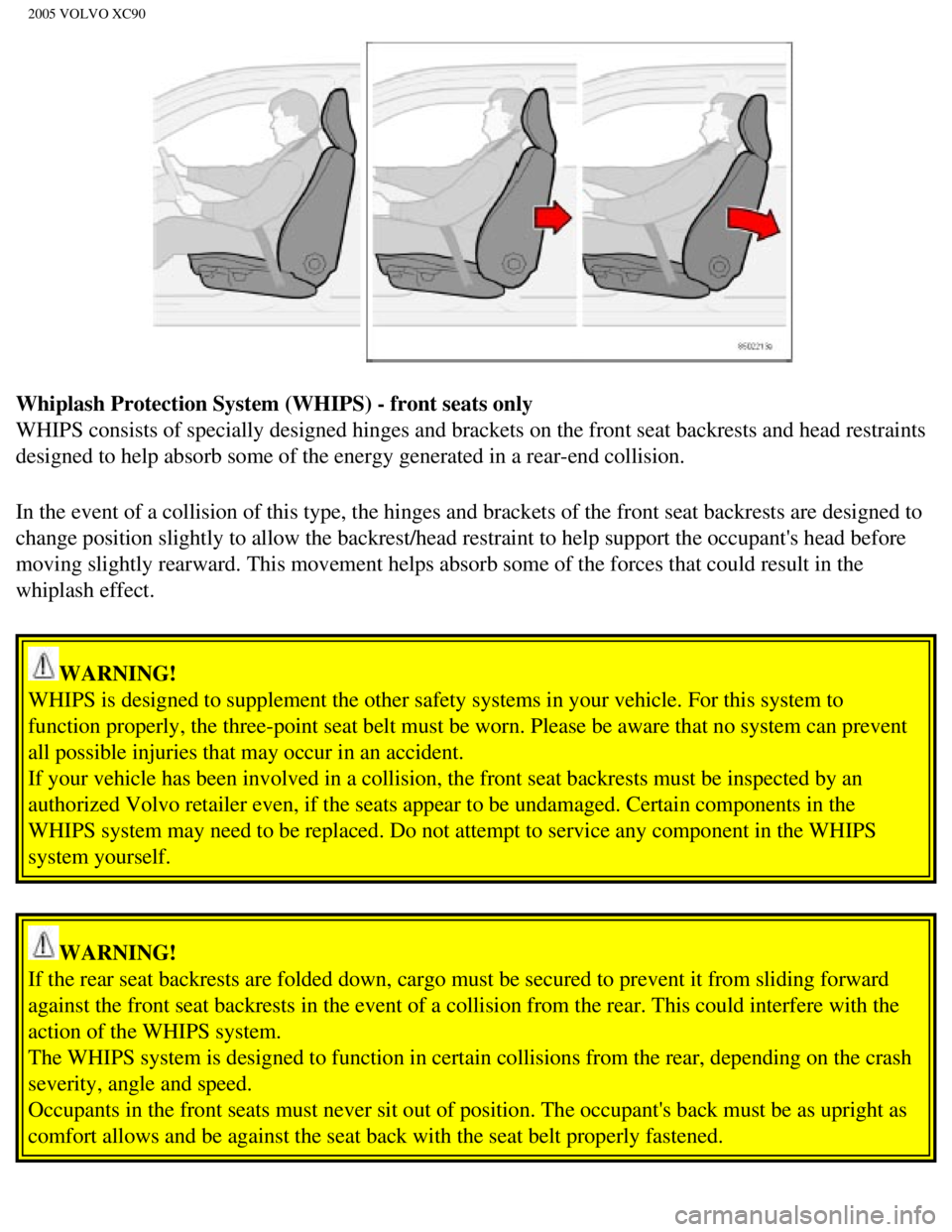
2005 VOLVO XC90
Whiplash Protection System (WHIPS) - front seats only
WHIPS consists of specially designed hinges and brackets on the front se\
at backrests and head restraints
designed to help absorb some of the energy generated in a rear-end colli\
sion.
In the event of a collision of this type, the hinges and brackets of the\
front seat backrests are designed to
change position slightly to allow the backrest/head restraint to help su\
pport the occupant's head before
moving slightly rearward. This movement helps absorb some of the forces \
that could result in the
whiplash effect.
WARNING!
WHIPS is designed to supplement the other safety systems in your vehicle\
. For this system to
function properly, the three-point seat belt must be worn. Please be awa\
re that no system can prevent
all possible injuries that may occur in an accident.
If your vehicle has been involved in a collision, the front seat backres\
ts must be inspected by an
authorized Volvo retailer even, if the seats appear to be undamaged. Cer\
tain components in the
WHIPS system may need to be replaced. Do not attempt to service any comp\
onent in the WHIPS
system yourself.
WARNING!
If the rear seat backrests are folded down, cargo must be secured to pre\
vent it from sliding forward
against the front seat backrests in the event of a collision from the re\
ar. This could interfere with the
action of the WHIPS system.
The WHIPS system is designed to function in certain collisions from the \
rear, depending on the crash
severity, angle and speed.
Occupants in the front seats must never sit out of position. The occupan\
t's back must be as upright as
comfort allows and be against the seat back with the seat belt properly \
fastened.
file:///K|/ownersdocs/2005/2005_XC90/05xc90_01b.htm (7 of 16)12/30/200\
6 4:42:25 PM
Page 30 of 263
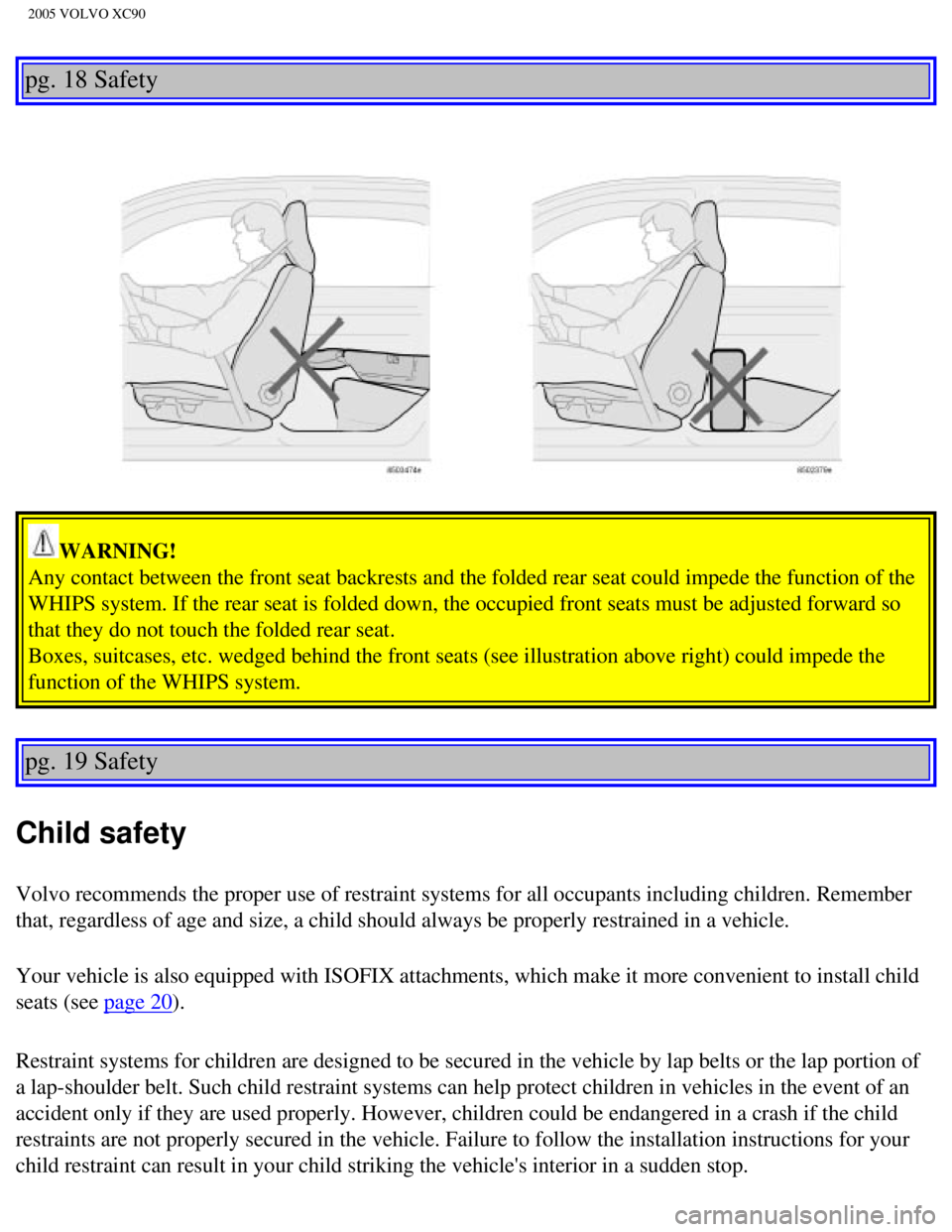
2005 VOLVO XC90
pg. 18 Safety
WARNING!
Any contact between the front seat backrests and the folded rear seat co\
uld impede the function of the
WHIPS system. If the rear seat is folded down, the occupied front seats \
must be adjusted forward so
that they do not touch the folded rear seat.
Boxes, suitcases, etc. wedged behind the front seats (see illustration \
above right) could impede the
function of the WHIPS system.
pg. 19 Safety
Child safety
Volvo recommends the proper use of restraint systems for all occupants i\
ncluding children. Remember
that, regardless of age and size, a child should always be properly rest\
rained in a vehicle.
Your vehicle is also equipped with ISOFIX attachments, which make it mor\
e convenient to install child
seats (see
page 20).
Restraint systems for children are designed to be secured in the vehicle\
by lap belts or the lap portion of
a lap-shoulder belt. Such child restraint systems can help protect child\
ren in vehicles in the event of an
accident only if they are used properly. However, children could be enda\
ngered in a crash if the child
restraints are not properly secured in the vehicle. Failure to follow th\
e installation instructions for your
child restraint can result in your child striking the vehicle's interior\
in a sudden stop.
file:///K|/ownersdocs/2005/2005_XC90/05xc90_01b.htm (8 of 16)12/30/200\
6 4:42:25 PM
Page 32 of 263
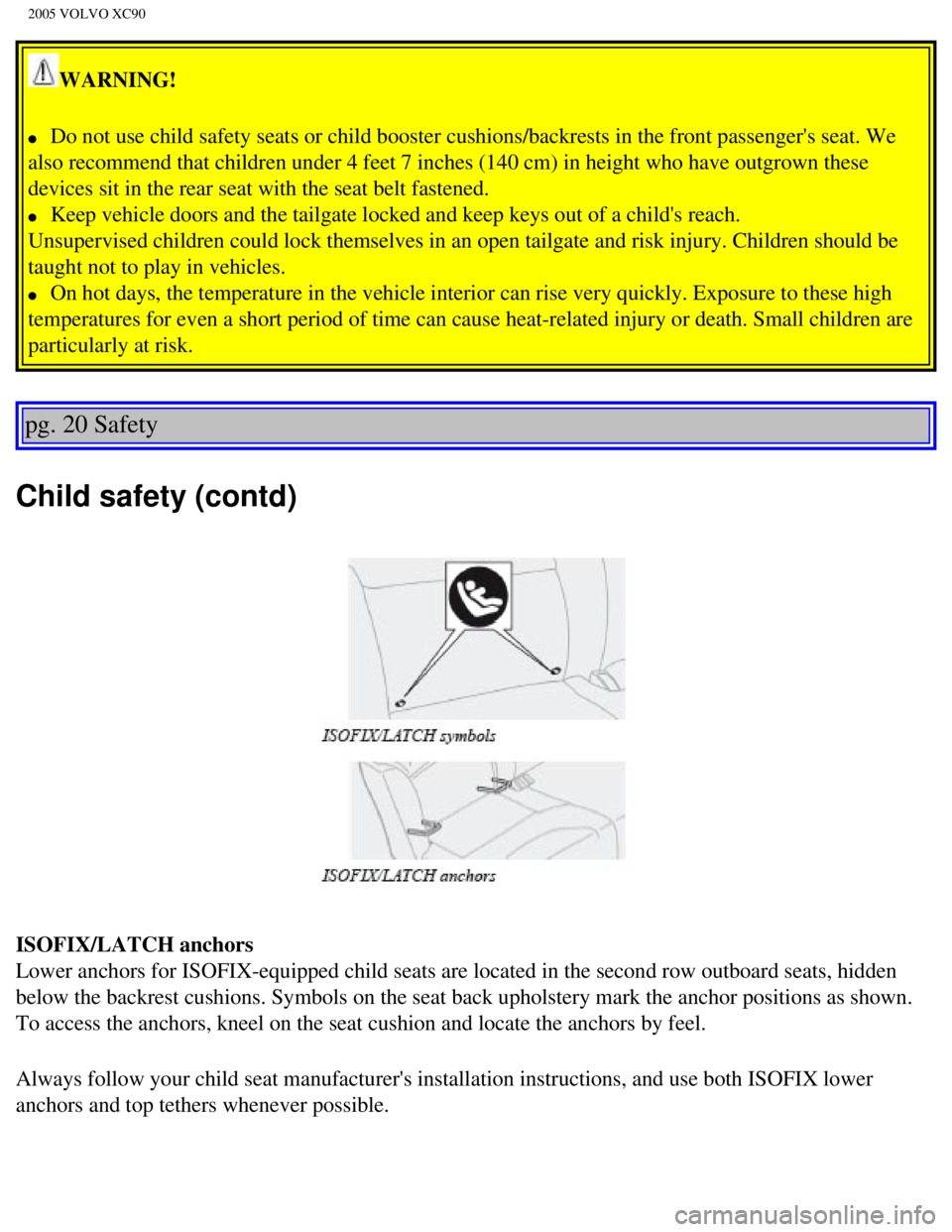
2005 VOLVO XC90
WARNING!
l Do not use child safety seats or child booster cushions/backrests in the\
front passenger's seat. We
also recommend that children under 4 feet 7 inches (140 cm) in height \
who have outgrown these
devices sit in the rear seat with the seat belt fastened.
l Keep vehicle doors and the tailgate locked and keep keys out of a child'\
s reach.
Unsupervised children could lock themselves in an open tailgate and risk\
injury. Children should be
taught not to play in vehicles.
l On hot days, the temperature in the vehicle interior can rise very quick\
ly. Exposure to these high
temperatures for even a short period of time can cause heat-related inju\
ry or death. Small children are
particularly at risk.
pg. 20 Safety
Child safety (contd)
ISOFIX/LATCH anchors
Lower anchors for ISOFIX-equipped child seats are located in the second \
row outboard seats, hidden
below the backrest cushions. Symbols on the seat back upholstery mark th\
e anchor positions as shown.
To access the anchors, kneel on the seat cushion and locate the anchors \
by feel.
Always follow your child seat manufacturer's installation instructions, \
and use both ISOFIX lower
anchors and top tethers whenever possible.
file:///K|/ownersdocs/2005/2005_XC90/05xc90_01b.htm (10 of 16)12/30/20\
06 4:42:25 PM
Page 33 of 263
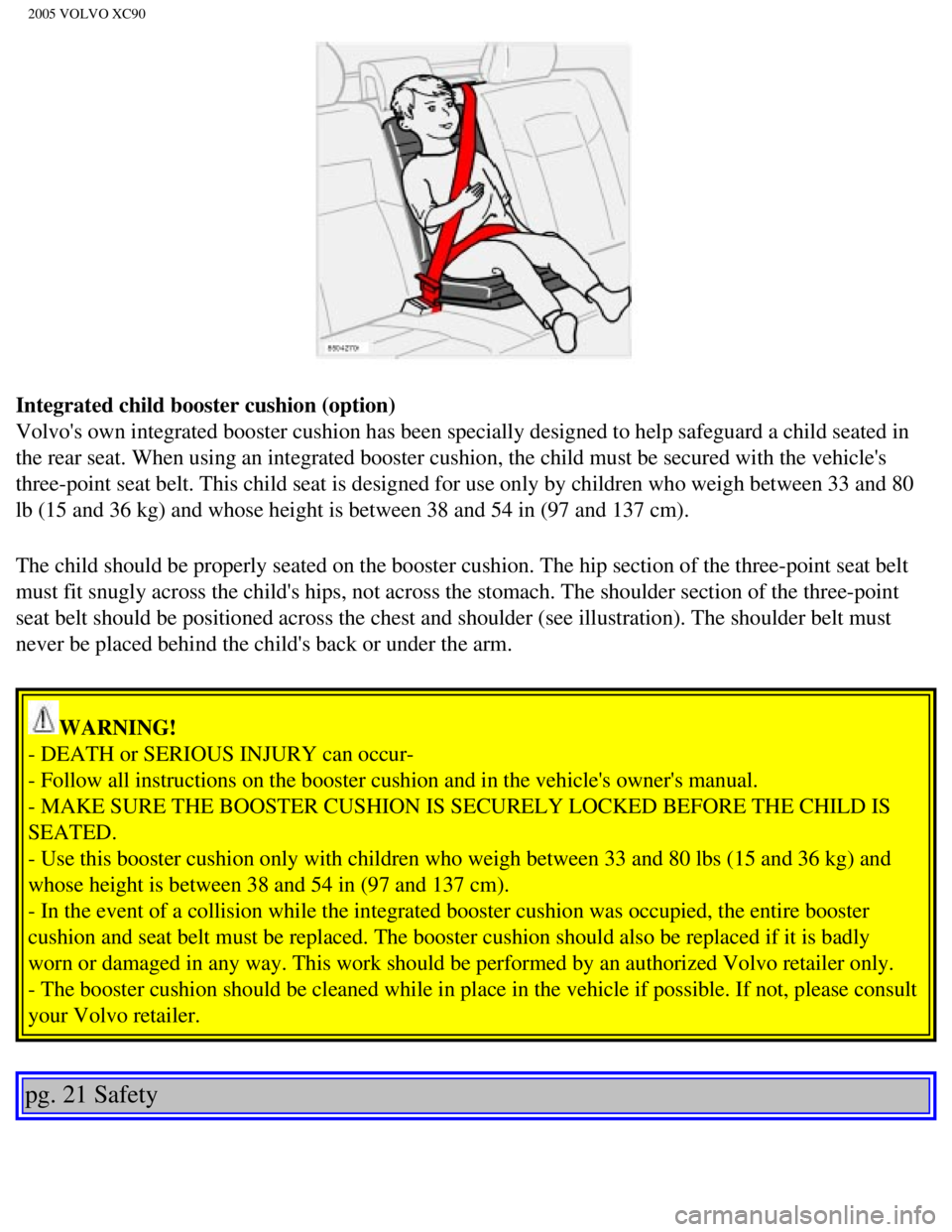
2005 VOLVO XC90
Integrated child booster cushion (option)
Volvo's own integrated booster cushion has been specially designed to he\
lp safeguard a child seated in
the rear seat. When using an integrated booster cushion, the child must \
be secured with the vehicle's
three-point seat belt. This child seat is designed for use only by child\
ren who weigh between 33 and 80
lb (15 and 36 kg) and whose height is between 38 and 54 in (97 and 13\
7 cm).
The child should be properly seated on the booster cushion. The hip sect\
ion of the three-point seat belt
must fit snugly across the child's hips, not across the stomach. The sho\
ulder section of the three-point
seat belt should be positioned across the chest and shoulder (see illus\
tration). The shoulder belt must
never be placed behind the child's back or under the arm.
WARNING!
- DEATH or SERIOUS INJURY can occur-
- Follow all instructions on the booster cushion and in the vehicle's ow\
ner's manual.
- MAKE SURE THE BOOSTER CUSHION IS SECURELY LOCKED BEFORE THE CHILD IS
SEATED.
- Use this booster cushion only with children who weigh between 33 and 8\
0 lbs (15 and 36 kg) and
whose height is between 38 and 54 in (97 and 137 cm).
- In the event of a collision while the integrated booster cushion was o\
ccupied, the entire booster
cushion and seat belt must be replaced. The booster cushion should also \
be replaced if it is badly
worn or damaged in any way. This work should be performed by an authoriz\
ed Volvo retailer only.
- The booster cushion should be cleaned while in place in the vehicle if\
possible. If not, please consult
your Volvo retailer.
pg. 21 Safety
file:///K|/ownersdocs/2005/2005_XC90/05xc90_01b.htm (11 of 16)12/30/20\
06 4:42:25 PM
Page 35 of 263
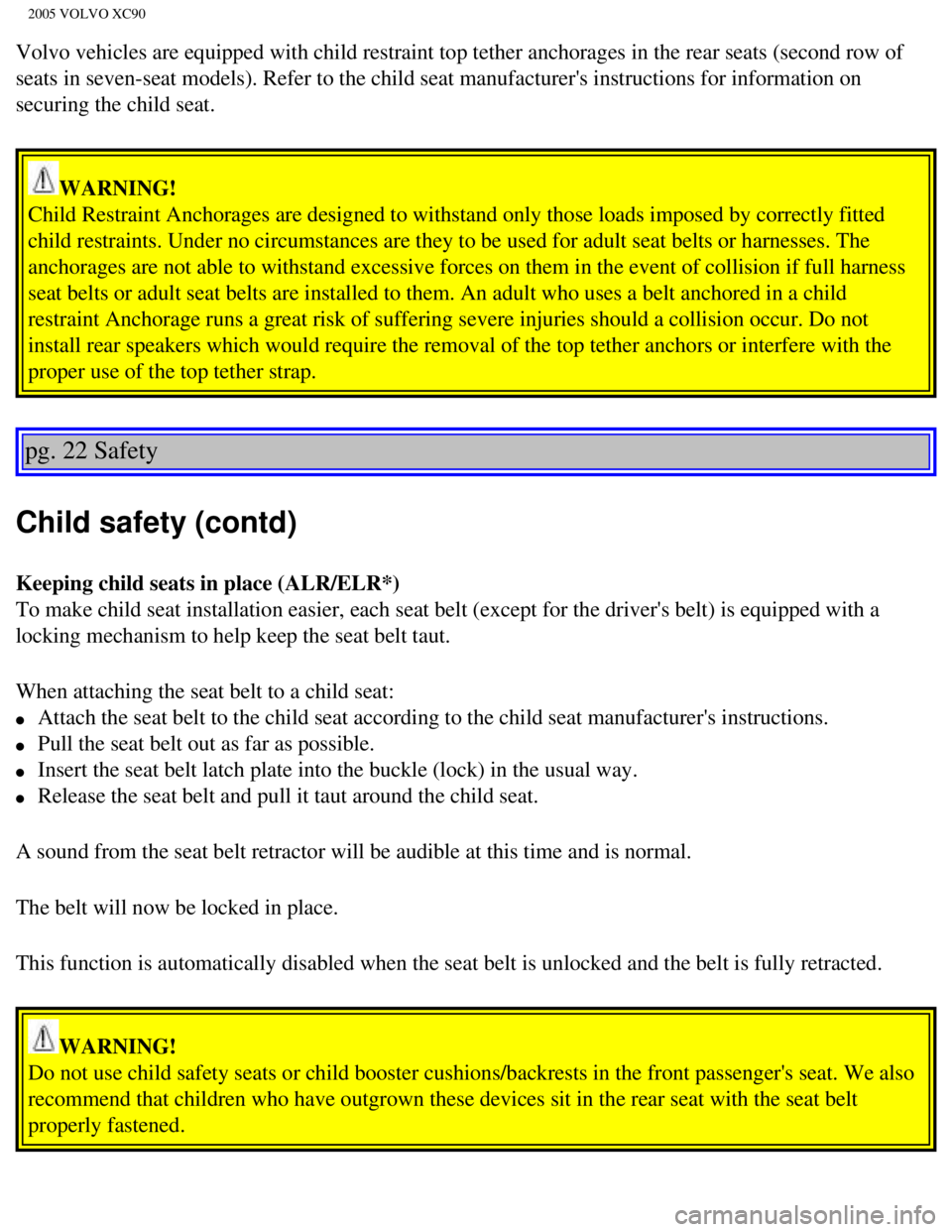
2005 VOLVO XC90
Volvo vehicles are equipped with child restraint top tether anchorages i\
n the rear seats (second row of
seats in seven-seat models). Refer to the child seat manufacturer's ins\
tructions for information on
securing the child seat.
WARNING!
Child Restraint Anchorages are designed to withstand only those loads im\
posed by correctly fitted
child restraints. Under no circumstances are they to be used for adult s\
eat belts or harnesses. The
anchorages are not able to withstand excessive forces on them in the eve\
nt of collision if full harness
seat belts or adult seat belts are installed to them. An adult who uses \
a belt anchored in a child
restraint Anchorage runs a great risk of suffering severe injuries shoul\
d a collision occur. Do not
install rear speakers which would require the removal of the top tether \
anchors or interfere with the
proper use of the top tether strap.
pg. 22 Safety
Child safety (contd)
Keeping child seats in place (ALR/ELR*)
To make child seat installation easier, each seat belt (except for the \
driver's belt) is equipped with a
locking mechanism to help keep the seat belt taut.
When attaching the seat belt to a child seat:
l Attach the seat belt to the child seat according to the child seat manuf\
acturer's instructions.
l Pull the seat belt out as far as possible.
l Insert the seat belt latch plate into the buckle (lock) in the usual w\
ay.
l Release the seat belt and pull it taut around the child seat.
A sound from the seat belt retractor will be audible at this time and is\
normal.
The belt will now be locked in place.
This function is automatically disabled when the seat belt is unlocked a\
nd the belt is fully retracted.
WARNING!
Do not use child safety seats or child booster cushions/backrests in the\
front passenger's seat. We also
recommend that children who have outgrown these devices sit in the rear \
seat with the seat belt
properly fastened.
file:///K|/ownersdocs/2005/2005_XC90/05xc90_01b.htm (13 of 16)12/30/20\
06 4:42:25 PM
Page 39 of 263
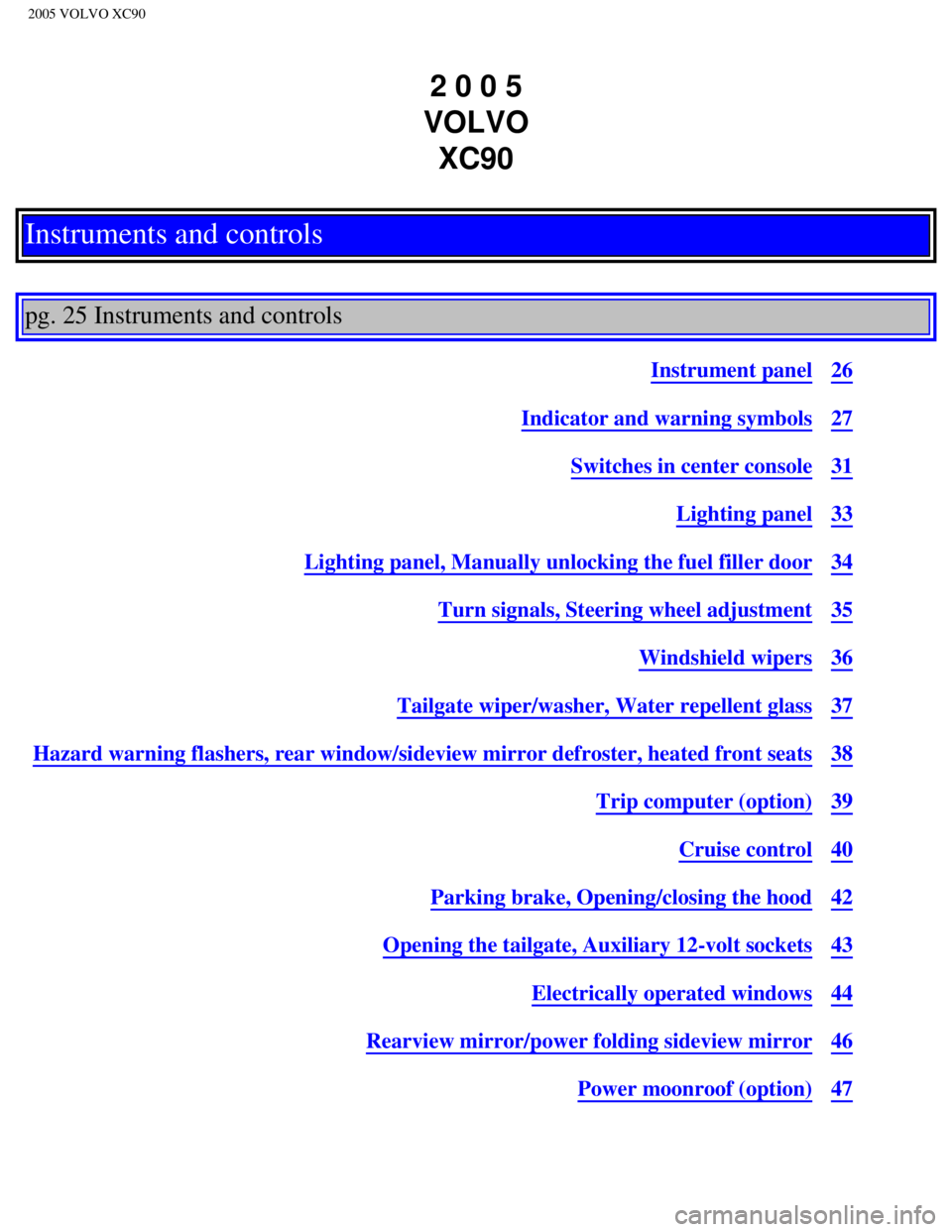
2005 VOLVO XC90
2 0 0 5
VOLVO XC90
Instruments and controls
pg. 25 Instruments and controls
Instrument panel26
Indicator and warning symbols27
Switches in center console31
Lighting panel33
Lighting panel, Manually unlocking the fuel filler door34
Turn signals, Steering wheel adjustment35
Windshield wipers36
Tailgate wiper/washer, Water repellent glass37
Hazard warning flashers, rear window/sideview mirror defroster, heated f\
ront seats38
Trip computer (option)39
Cruise control40
Parking brake, Opening/closing the hood42
Opening the tailgate, Auxiliary 12-volt sockets43
Electrically operated windows44
Rearview mirror/power folding sideview mirror46
Power moonroof (option)47
file:///K|/ownersdocs/2005/2005_XC90/05xc90_02a.htm (1 of 17)12/30/200\
6 4:42:27 PM
Page 40 of 263

2005 VOLVO XC90
pg. 26 Instruments and controls
Instrument panel
1. Turn signal indicators - right - left
2. Text window
The text window displays information and warning messages.
3. Temperature gauge
The pointer should be approximately midway on the gauge when driving. Do not drive the vehicle if
the warning light is on. The text window will provide you with additional information. If the en\
gine
temperature remains high, check coolant level - see
page 139.
4. Trip odometer
The trip odometers are used for measuring shorter distances. The right-h\
and digit gives tenth of a mile/
kilometer. Press the button for more than 2 seconds to reset. Change bet\
ween trip odometers 1 and 2
using one short press on the button.
5. Odometer
6. Speedometer
7. Warning symbol
8. High beam indicator
9. Tachometer
The tachometer shows engine speed in thousands of revolutions per minute\
(rpm). Do not drive
file:///K|/ownersdocs/2005/2005_XC90/05xc90_02a.htm (2 of 17)12/30/200\
6 4:42:27 PM
Page 41 of 263

2005 VOLVO XC90
continuously with the needle in the red area of the dial, which indicate\
s maximum allowable engine rpm
range. Instead, shift to a higher gear or slow the vehicle down. The eng\
ine management system will
automatically prevent excessively high engines speeds. This will be noti\
ceable as a pronounced
unevenness in engine speed.
10. Gear and driving mode indicator
The currently selected driving mode is displayed here. If you use the op\
tional Geartronic function on the
automatic transmission, the currently selected gear will be displayed.
11. Ambient temperature gauge
This display indicates the air temperature outside your vehicle. A "snow\
flake" symbol in the text
window is displayed when the temperature is in the range of 23 - 36° \
F (-5 - +2° C). Please note that this
symbol does not indicate a fault with your vehicle. At low speeds or whe\
n the vehicle is not moving, the
temperature readings may be slightly higher than the actual ambient temp\
erature.
12. Clock/set button
Turn the button to set the clock.
13. Fuel gauge
The fuel tank holds approximately:
Models with 6-cylinder turbo engines - 19 US gallons (72 liters).
Models with 5-cylinder turbo engines - 18 US gallons (68 liters).
When a warning light in the gauge comes on, there are approximately 1.8 \
US gal. (8 liters) of fuel
remaining in the tank.
14. Indicator and warning symbols
pg. 27 Instruments and controls
Indicator and warning symbols
The indicator and warning symbols light up when you turn the ignition ke\
y to the driving position
(position II) before starting. This shows that the symbols are functio\
ning. When the engine starts, all
symbols go out. If the engine is not started within 5 seconds, all symbo\
ls except CHECK ENGINE and
go out. The symbol for the parking brake goes out when the parking brak\
e is released.
Warning symbol
in center of instrument panel
This symbol shines as a red or yellow light depending on the severity of\
the fault that has been detected.
Red symbol -Stop the vehicle as soon as possible in a suitable location and read th\
e message shown in
file:///K|/ownersdocs/2005/2005_XC90/05xc90_02a.htm (3 of 17)12/30/200\
6 4:42:27 PM